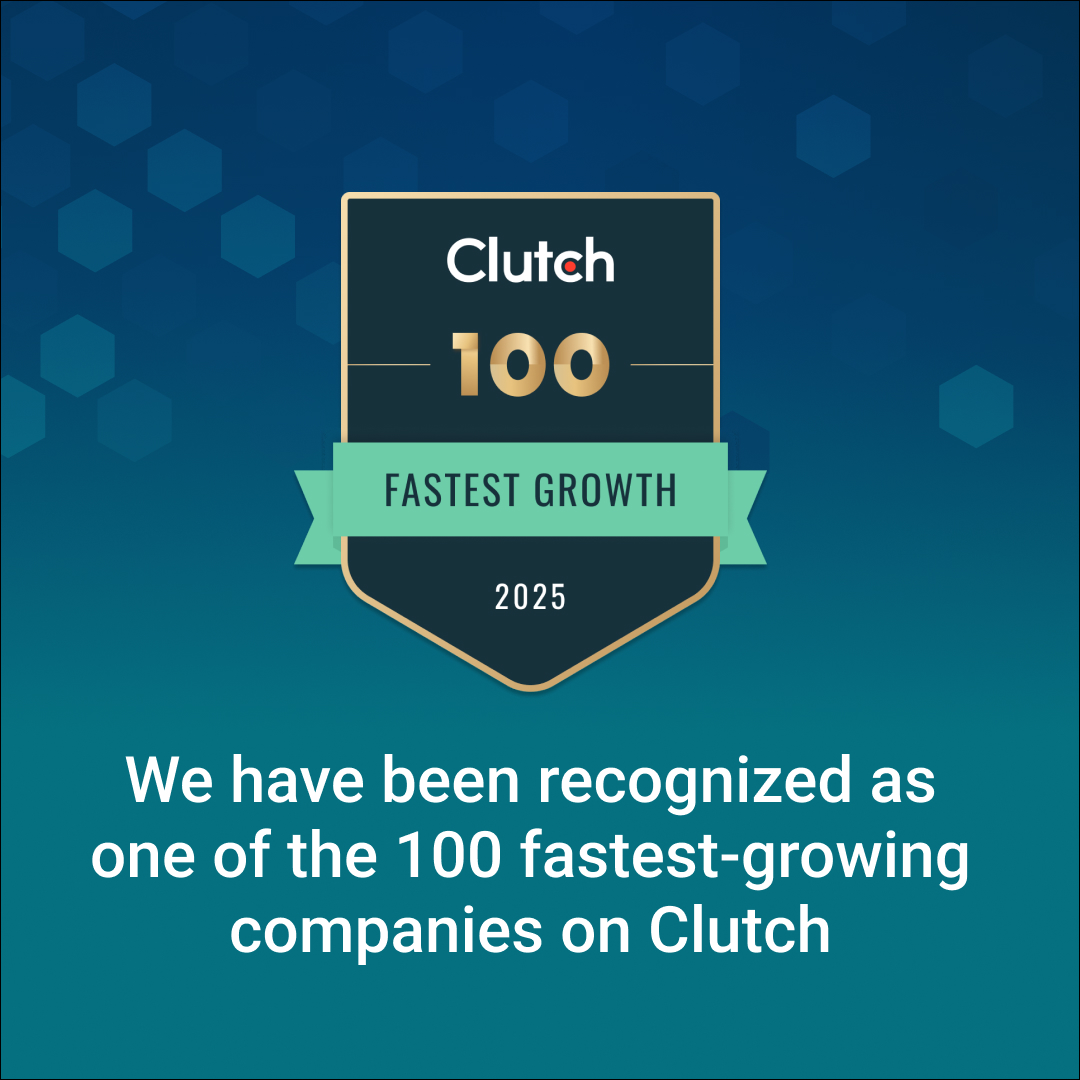Introduction
The renewable energy sector faces challenges like variable generation, inefficient storage, and complex grid integration. AI offers solutions to optimize production, improve forecasting, and streamline grid management. By leveraging machine learning and predictive analytics, AI enhances efficiency and reduces costs. This guide explores how AI is transforming renewable energy, addressing key obstacles and driving tangible benefits.
What is AI and Why Does It Matter in Renewable Energy?
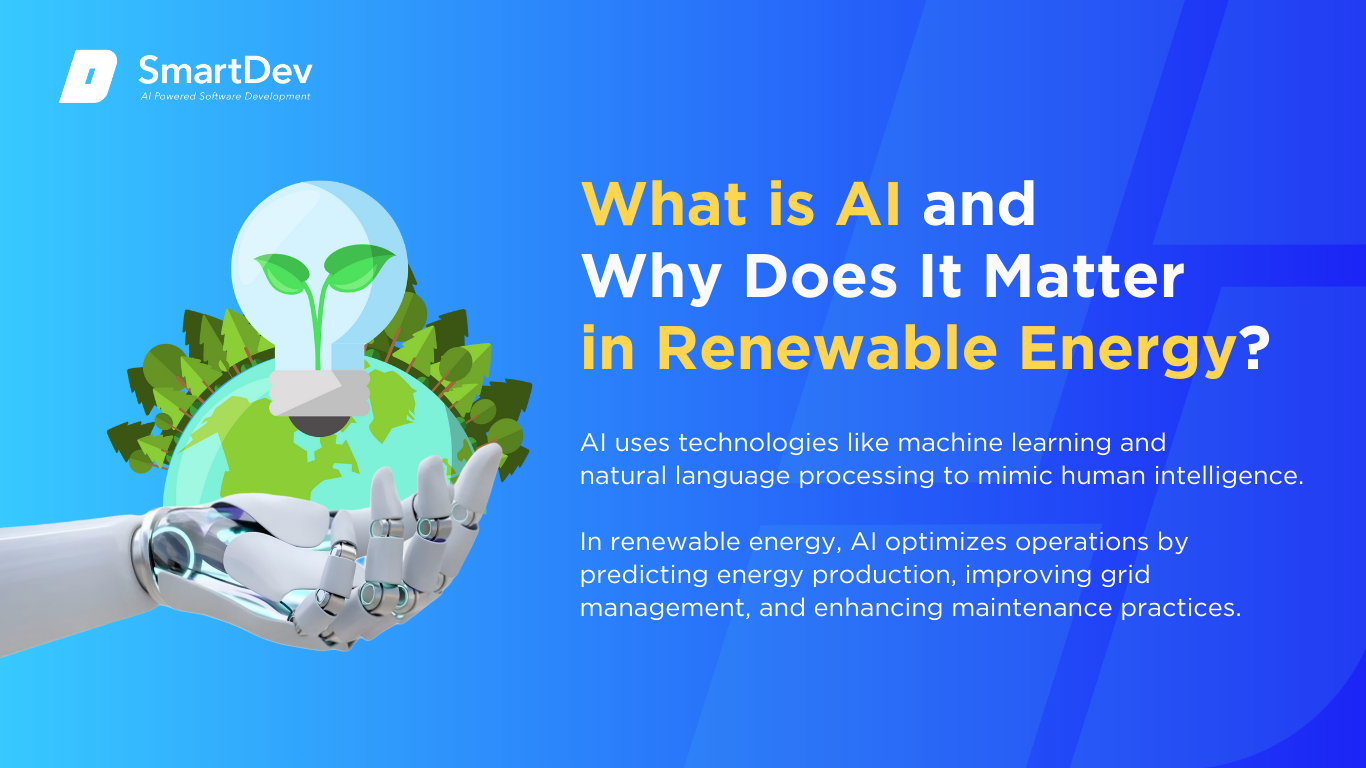
Definition of AI and Its Core Technologies
Artificial Intelligence (AI) refers to systems that perform tasks requiring human-like intelligence, such as learning and decision-making. Key AI technologies, including machine learning, natural language processing (NLP), and computer vision, enable machines to analyze large data sets and make informed decisions. These technologies form the basis for AI applications across industries, including renewable energy.
In renewable energy, AI optimizes operations by predicting energy production, improving grid management, and enhancing maintenance practices. Machine learning algorithms, for instance, help forecast energy output based on weather patterns, while NLP analyzes data for efficiency insights. By leveraging AI, energy companies can automate processes, reduce costs, and improve overall system performance.
To understand how broader technology shifts are reshaping industries, our summary of 2024 IT trends highlights the most significant forces driving AI adoption across sectors.
The Growing Role of AI in Transforming Renewable Energy
AI is increasingly shaping the renewable energy landscape by enhancing energy production and operational efficiency. With the ability to process vast amounts of data, AI optimizes energy generation based on real-time weather conditions, such as wind speed or solar radiation. This enables renewable energy assets like wind turbines and solar panels to perform at their peak capacity.
In addition to improving energy production, AI is revolutionizing grid management. It can forecast fluctuations in energy supply and demand, allowing for better integration of renewable sources into existing grid systems. By dynamically adjusting energy distribution, AI ensures a more reliable and balanced power supply, even with the variability of renewable energy.
AI is also playing a key role in predictive maintenance for renewable energy infrastructure. By analyzing data from sensors, AI can predict equipment failures before they occur, enabling timely interventions. This reduces downtime, extends the lifespan of assets, and ultimately lowers operational costs, making renewable energy systems more sustainable and cost-effective.
Key Statistics and Trends Highlighting AI Adoption in Renewable Energy
AI adoption in renewable energy is rapidly growing, with the global market valued at $16.19 billion in 2024 and projected to reach $158.76 billion by 2034, growing at a CAGR of 25.65%. This growth is driven by AI’s ability to optimize energy generation, improve grid management, and enhance predictive maintenance.
The Asia-Pacific region currently leads AI adoption in renewable energy, holding a 49% market share in 2024, while North America is expected to see the fastest growth due to advancements in smart grid technology. AI applications like demand forecasting, grid management, and maintenance are key factors in driving this trend.
However, challenges remain in implementing AI effectively. A 2024 survey by Boston Consulting Group found that while 60% of energy leaders expect AI to deliver results within a year, 70% are dissatisfied with their progress due to issues like data quality and integration complexities.
Business Benefits of AI in Renewable Energy
AI is transforming renewable energy by optimizing operations, enhancing efficiency, and reducing costs. From improving forecasting accuracy to streamlining grid management, AI is delivering tangible benefits that help companies increase performance and sustainability.
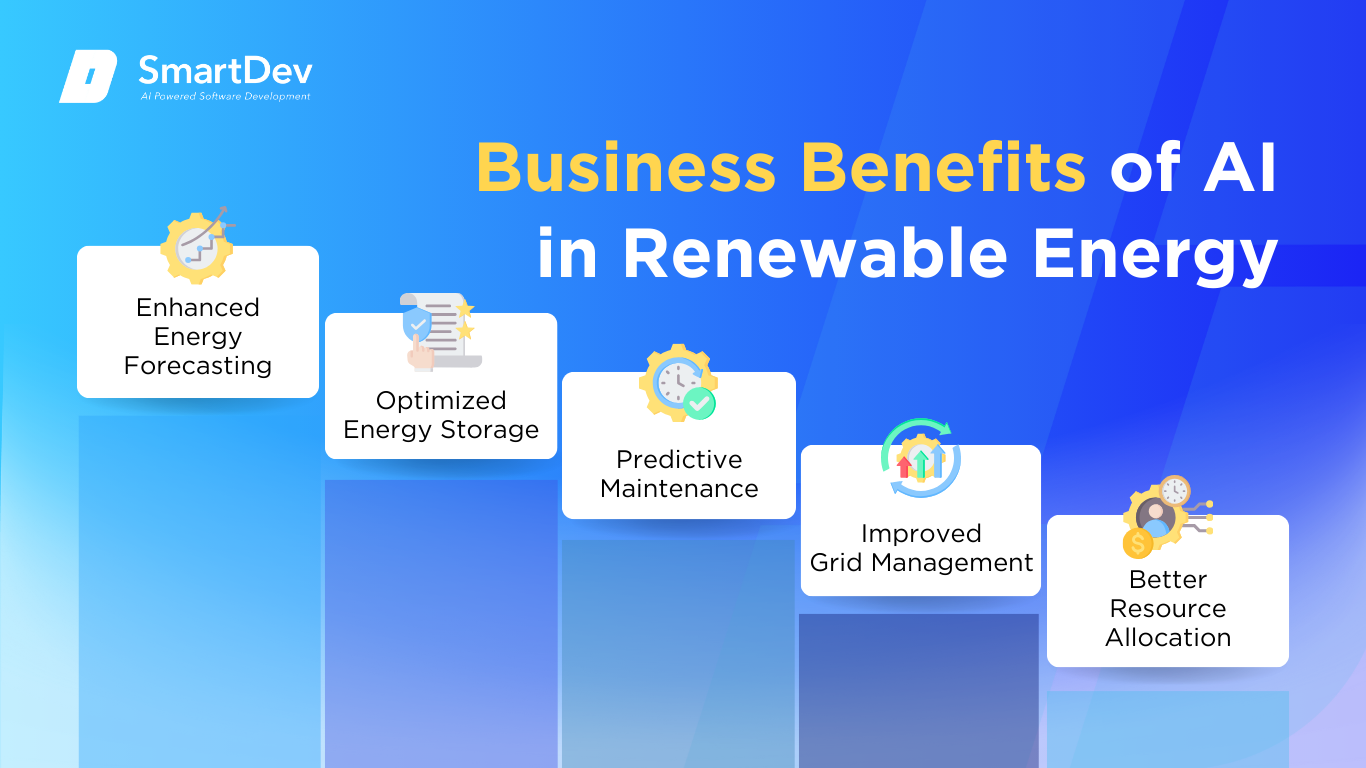
1. Enhanced Energy Forecasting
AI significantly improves the accuracy of energy forecasting for variable renewable sources such as wind and solar. By leveraging historical data, real-time weather conditions, and machine learning algorithms, AI can predict energy generation with remarkable precision. This allows energy producers to better anticipate fluctuations, leading to a more reliable and stable energy supply.
Accurate forecasting also helps grid operators balance supply and demand, reducing the need for backup power from non-renewable sources. Additionally, it optimizes energy storage by ensuring excess energy is stored during peak generation, enhancing overall system efficiency and supporting a more sustainable infrastructure.
2. Optimized Energy Storage
AI plays a key role in optimizing energy storage by determining the most efficient times to charge and discharge energy storage systems. Using real-time data and predictive models, AI enhances the performance of large-scale storage, minimizing energy losses and maximizing capacity utilization. This leads to a more efficient deployment of stored energy when it’s most needed.
Efficient energy storage is essential for integrating intermittent renewable sources into the grid. AI helps store excess energy during peak production and releases it during low-generation periods, reducing reliance on fossil fuel-based backup. This leads to a more reliable, consistent, and sustainable energy supply, supporting the growth of renewable energy.
3. Predictive Maintenance for Renewable Energy Assets
AI-driven predictive maintenance boosts the longevity and performance of renewable energy assets, such as wind turbines and solar panels. Continuous monitoring and data analysis allow AI to detect early signs of wear and failure, enabling timely interventions that prevent major issues. This proactive approach reduces unplanned downtime and extends the lifespan of assets, ensuring consistent energy production.
The financial benefits of predictive maintenance are significant, as it helps avoid costly repairs and minimizes downtime. By identifying potential issues early, AI improves the reliability and efficiency of renewable energy systems. This results in reduced operational costs, increased productivity, and higher returns on renewable energy investments.
4. Improved Grid Management
AI optimizes grid management by predicting renewable energy production and demand, enabling real-time adjustments. Through advanced algorithms, AI allows grid operators to balance energy supply and demand, ensuring efficient distribution and reducing reliance on non-renewable sources. This helps integrate renewable energy more seamlessly into the grid, improving overall system performance.
Beyond improving stability, AI enhances the grid’s responsiveness to unexpected supply or demand changes. By automating real-time adjustments, AI ensures greater grid flexibility and resilience. This reduces operational costs and improves the reliability of the grid, allowing a higher share of renewable energy to be integrated efficiently.
5. Better Resource Allocation
AI improves resource allocation by analyzing real-time data to predict energy consumption and optimize distribution. It considers factors like weather forecasts and historical usage patterns, helping operators allocate energy more efficiently and reduce waste. This leads to smarter energy deployment, ensuring that resources are used where they are most needed.
This improved allocation helps renewable energy companies reduce operational costs while increasing overall system efficiency. AI also supports smarter investment decisions by identifying areas where additional capacity or infrastructure is required. As a result, energy companies can better plan for the future, scaling operations in line with demand and maximizing profitability.
Challenges Facing AI Adoption in Renewable Energy
While AI offers significant advantages, its adoption in renewable energy comes with several challenges. Issues like data fragmentation, high costs, and a shortage of skilled talent must be addressed for AI to reach its full potential in the sector.
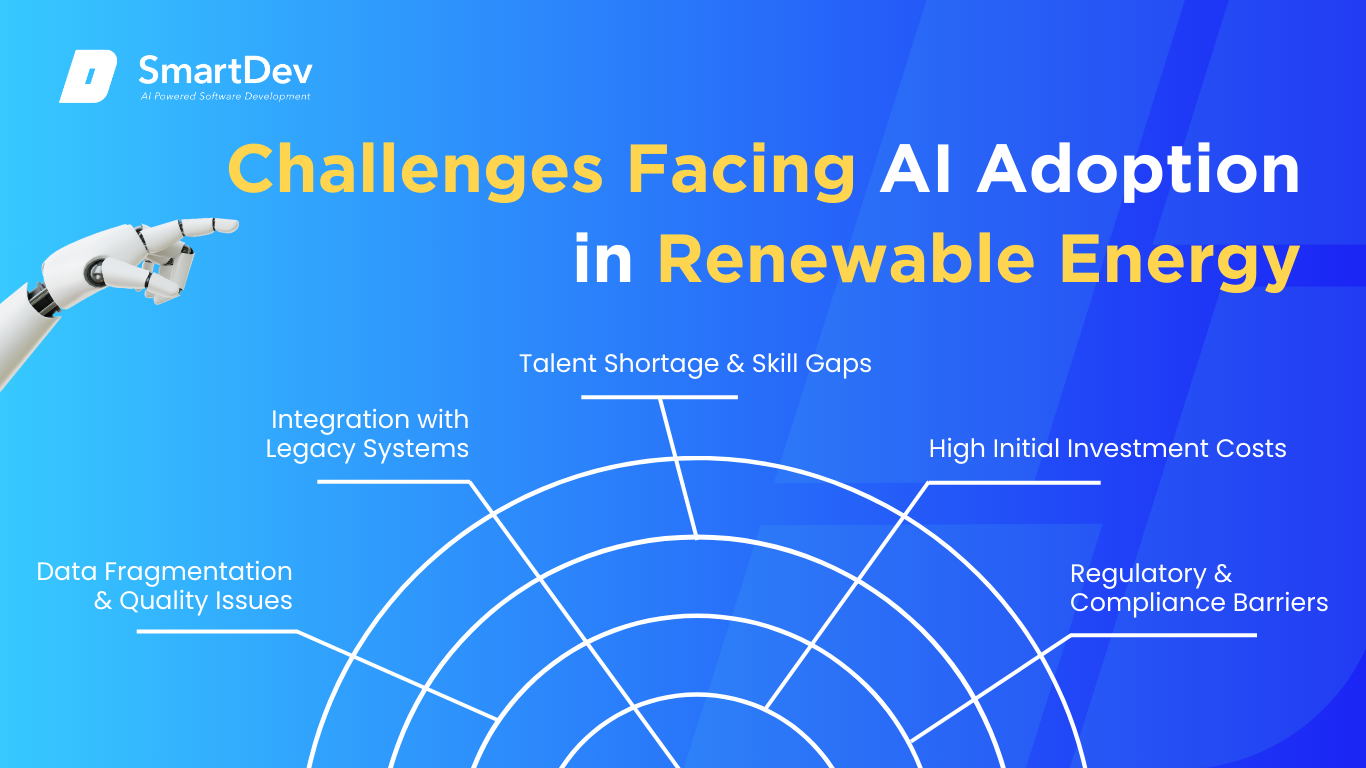
1. Data Fragmentation and Quality Issues
Data fragmentation and quality issues are significant barriers to AI adoption in renewable energy. Data is often scattered across various systems, making it difficult for AI to generate accurate insights. Inconsistent or inaccurate data can lead to unreliable predictions, limiting the effectiveness of AI applications.
To address this, companies must invest in centralized data platforms and ensure data standardization. High-quality, unified data is crucial for AI to function effectively and deliver the desired outcomes in operations.
To learn how unstructured data can be effectively leveraged in AI applications, check out our detailed guide on how AI unlocks the power of unstructured data.
2. Integration with Legacy Systems
Integrating AI with legacy systems can be complex and costly, as many renewable energy companies still rely on outdated technologies. Compatibility issues often arise, requiring extensive upgrades to hardware and software. These integration challenges can delay AI adoption and hinder its potential to optimize operations.
A well-planned approach, including modernizing infrastructure and collaborating with AI providers, is key to successful integration. Without this, companies risk missing out on the operational efficiencies AI can offer.
For a practical example of overcoming similar integration challenges, see our case study on Scaling BOLDR with AWS: Building a Secure and Flexible Infrastructure, which shows how cloud-native solutions streamline modernization while maintaining reliability.
3. High Initial Investment Costs
AI adoption requires a significant upfront investment in infrastructure, software, and specialized talent, which can be a barrier for smaller companies. The initial financial outlay, while justified by long-term savings, can deter many organizations from adopting AI technologies.
To mitigate this, companies can consider pilot projects, seek external funding, or partner with AI providers. A gradual approach allows them to demonstrate value while managing costs effectively.
4. Talent Shortage and Skill Gaps
There is a shortage of skilled professionals with expertise in both AI and renewable energy, which slows down the deployment of AI solutions. This skills gap limits the potential benefits of AI, as companies struggle to find qualified talent to implement and manage these systems.
Renewable energy companies must invest in training programs, collaborate with universities, and partner with third-party AI providers to bridge this gap. Building internal capabilities or leveraging external expertise is crucial for successful AI adoption.
5. Regulatory and Compliance Barriers
Regulatory and compliance issues related to data privacy and security can complicate AI implementation. Renewable energy companies must adhere to local and international regulations, which can slow down the integration of AI technologies.
To navigate these challenges, companies need to stay updated on regulations and ensure AI systems comply with data protection standards. Collaborating with legal and cybersecurity experts will help mitigate risks and ensure smooth AI adoption.
Specific Applications of AI in Renewable Energy
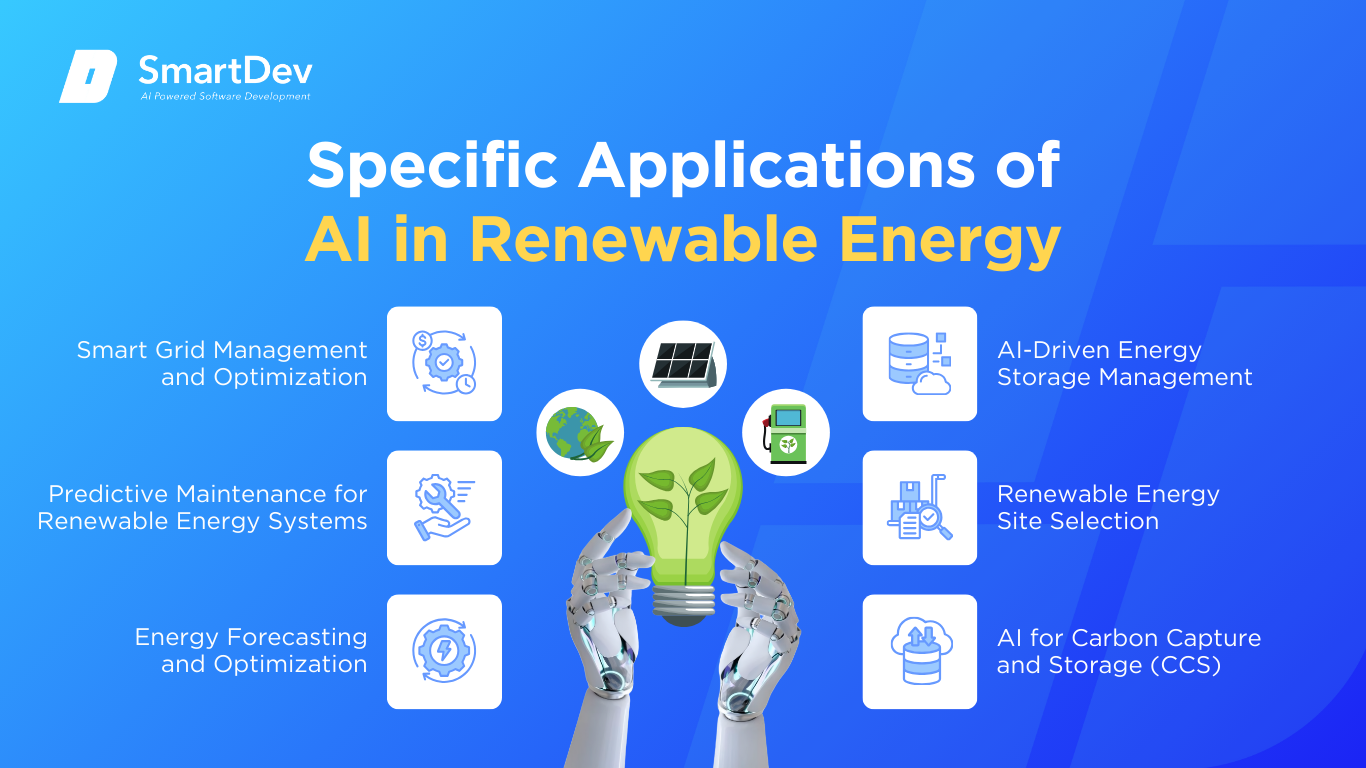
1. Smart Grid Management and Optimization
AI enhances smart grid management by forecasting energy demand and optimizing renewable energy distribution. Machine learning algorithms analyze historical data and weather patterns to predict energy consumption, helping grids integrate renewable sources like wind and solar more effectively. This optimization reduces reliance on fossil fuels and balances supply and demand more efficiently.
AI also increases grid reliability by detecting faults and inefficiencies in real-time. Predictive maintenance helps prevent system failures, reducing downtime and operational costs. As renewable energy use grows, AI-powered grids ensure a stable and efficient power supply.
This advanced management also reduces energy waste by dynamically adjusting the grid’s operation based on real-time data. As a result, AI helps make renewable energy integration more efficient, fostering a cleaner, more sustainable energy system.
Real‑World Example:
The National Grid ESO in the UK uses AI to forecast energy demand and renewable output, helping reduce reliance on fossil fuels during high-demand periods. The AI-powered optimization has enabled periods of 100% zero carbon electricity generation with no fossil fuels used.
2. Predictive Maintenance for Renewable Energy Systems
AI is revolutionizing maintenance for renewable energy systems by predicting potential equipment failures. Wind turbines and solar panels use real-time sensor data, which AI analyzes to spot early signs of wear. This allows for timely maintenance, reducing unexpected downtime and extending the life of equipment.
As AI algorithms process more data, their predictive accuracy improves, enabling more efficient maintenance schedules. This reduces repair costs and operational disruptions, ensuring consistent energy production. AI also helps avoid unnecessary maintenance, optimizing both time and resources.
AI-powered predictive maintenance also maximizes energy production by keeping equipment in optimal working condition. By preventing downtime and identifying faults early, AI helps reduce maintenance costs and increase the overall efficiency of renewable energy systems.
Real‑World Example:
Siemens Gamesa uses AI-driven predictive maintenance to monitor its fleet of wind turbines globally. This technology has led to a significant reduction in unscheduled downtime and maintenance costs, while increasing energy production.
3. Energy Forecasting and Optimization
AI-driven forecasting helps optimize the integration of renewable energy by predicting wind and solar power production. By analyzing weather data and historical energy generation patterns, AI accurately forecasts when renewable energy will be abundant or scarce. This enables better planning and grid management, especially when balancing renewable energy with conventional energy sources.
Energy storage systems benefit from these predictions as AI determines when to store surplus energy and when to release it. This reduces waste and reliance on fossil-fuel-based energy sources. Optimizing storage helps reduce grid instability during periods of high demand or low renewable production.
With accurate forecasting, grid operators can also make better decisions about when to purchase or sell electricity, optimizing costs and energy availability. This increases the overall economic feasibility of renewable energy by improving the operational efficiency of energy systems.
Real‑World Example:
EDF Energy in the UK utilizes AI for advanced energy forecasting. Their AI models predict renewable generation output, helping them optimize grid balancing and reduce dependence on gas power.
4. AI-Driven Energy Storage Management
AI optimizes energy storage by predicting when to store and release energy. This helps renewable energy systems like solar and wind, which are variable, become more reliable by ensuring that surplus energy is stored during peak production times and used when production is low. This allows energy storage systems to operate more efficiently.
Real-time monitoring and AI analysis of grid conditions enable better battery life management and maximize storage utilization. AI also improves decision-making regarding grid stability and energy dispatch, ensuring stored energy is deployed most effectively.
As AI optimizes energy storage, it reduces the need for fossil fuel-based backup power during periods of high demand. This not only makes energy systems more sustainable but also reduces operational costs associated with energy supply.
Real‑World Example:
Fluence Energy uses AI to manage large-scale energy storage systems globally. Their AI-driven platform helps balance the storage and discharge of energy, ensuring that grids are more reliable and reducing reliance on fossil fuels.
5. Renewable Energy Site Selection
AI optimizes the selection of sites for renewable energy projects by evaluating geographical, environmental, and economic factors. Using advanced machine learning, AI predicts the best locations for wind farms, solar installations, and other renewable projects. This reduces site-selection risks and accelerates project deployment.
By considering local weather patterns, environmental regulations, and land use, AI enables developers to make more informed decisions. It ensures that renewable projects are built where they will generate the most energy with the least environmental and logistical challenges.
AI-driven site selection accelerates the transition to clean energy by making project development more efficient. With optimized site choices, renewable energy projects can start generating power sooner, speeding up the global adoption of sustainable energy.
Real‑World Example:
NREL uses AI to analyze potential sites for wind energy installations. Their AI models evaluate meteorological data and land suitability, ensuring optimal site selection for maximum energy generation.
6. AI for Carbon Capture and Storage (CCS)
AI enhances carbon capture and storage (CCS) by optimizing CO2 capture processes in real-time. Using machine learning models, CCS systems can predict the most effective conditions for capturing CO2 and improving absorption rates. This makes the entire process more efficient and cost-effective, reducing carbon emissions from industrial sources.
AI also plays a crucial role in monitoring CO2 storage sites, analyzing data from sensors to detect leaks and ensure long-term safety. This early detection of potential issues ensures that CO2 remains safely stored underground, minimizing environmental risks.
By improving efficiency and reducing operational costs, AI helps scale CCS technologies to a level where they can be a key part of global efforts to reduce carbon emissions and mitigate climate change.
Real‑World Example:
Drax Group in the UK employs AI to monitor and optimize CO2 capture and storage. This project uses AI to predict CO2 storage behavior and detect potential leaks, enhancing the reliability of carbon storage solutions.
Need Expert Help Turning Ideas Into Scalable Products?
Partner with SmartDev to accelerate your software development journey — from MVPs to enterprise systems.
Book a free consultation with our tech experts today.
Let’s Build TogetherExamples of AI in Renewable Energy
AI adoption in renewable energy is driving tangible advancements in efficiency, sustainability, and cost reduction. The following case studies illustrate how prominent companies are leveraging AI to optimize energy production, enhance storage solutions, and accelerate the transition to a cleaner energy future.
Real-World Case Studies
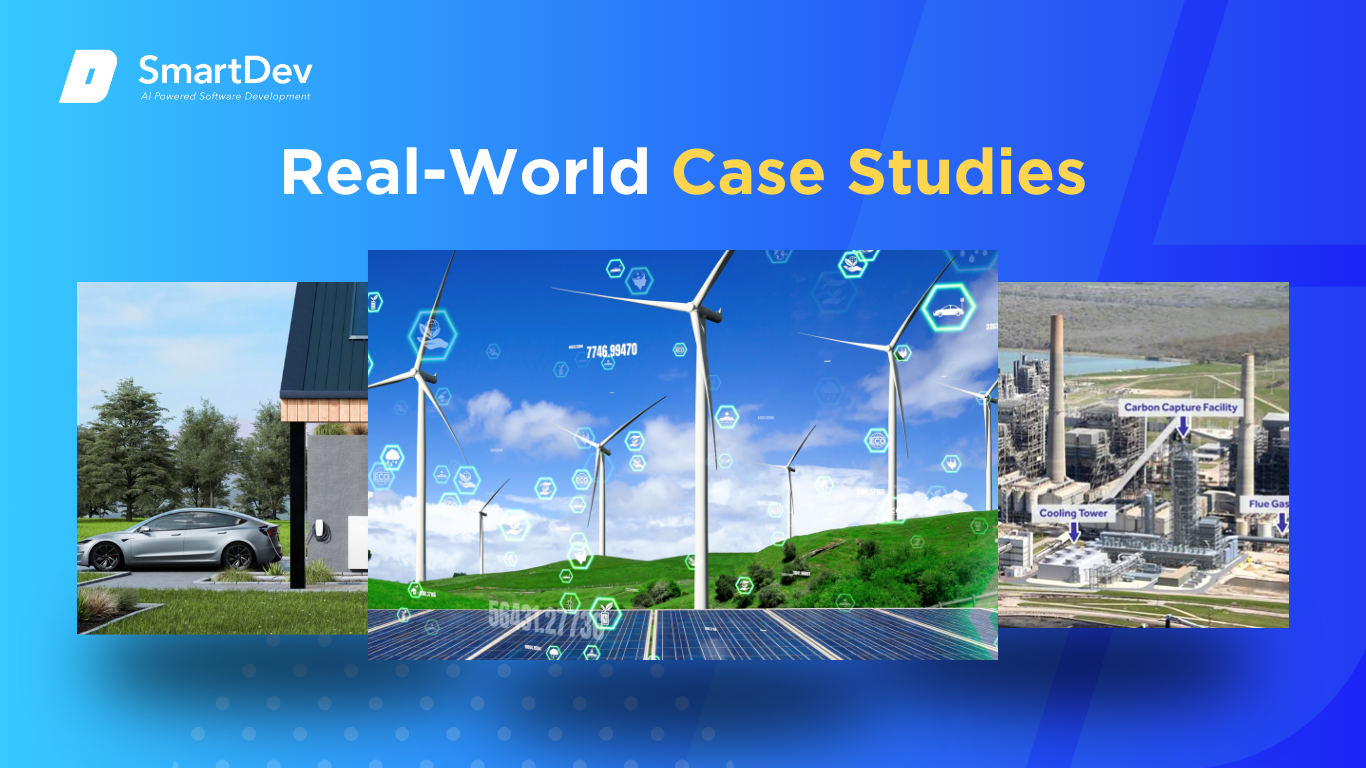
1. Google: AI-Powered Renewable Energy Optimization
Google leverages AI to optimize energy use across its global data centers. The AI system forecasts energy demand and adjusts operations to ensure that the data centers run on renewable energy whenever possible, improving efficiency and reducing carbon emissions.
Additionally, AI helps Google strategically invest in renewable energy by forecasting the availability of wind and solar power. This allows the company to match its energy needs with renewable energy supply, helping it meet its goal of 100% renewable energy usage for its operations.
2. Tesla: AI and Energy Storage with Powerwall
Tesla’s Powerwall uses AI to optimize solar energy storage, analyzing consumption patterns to efficiently manage energy use. The system ensures that homes maximize their use of stored solar energy, reducing reliance on grid electricity during peak demand.
AI is also used in Tesla’s Hornsdale Power Reserve in Australia to optimize large-scale energy storage. This helps capture excess renewable energy, ensuring efficient storage and discharge, stabilizing the grid, and reducing dependence on fossil fuels.
3. Petra Nova: CCS Project in Texas
The Petra Nova project in Texas uses AI to optimize CO2 capture at the W.A. Parish power plant. Real-time data analysis allows AI to improve capture efficiency, reducing CO2 emissions and ensuring more effective storage.
AI also monitors the CO2 storage site, analyzing sensor data to detect potential leaks and ensuring the safety of the underground storage. This proactive monitoring minimizes environmental risks, making Petra Nova a reliable CCS solution.
Innovative AI Solutions
AI is driving significant advancements in renewable energy by optimizing energy forecasting and grid integration. Machine learning algorithms analyze data to predict renewable energy output more accurately, enabling better supply and demand balancing. This reduces reliance on fossil fuels and enhances the integration of variable sources like wind and solar.
AI is also transforming energy storage management, ensuring excess renewable energy is stored during low-demand periods and released when needed. This optimization minimizes the need for backup non-renewable generation and improves the cost-effectiveness of renewable energy systems. Such innovations contribute to a more sustainable and efficient energy future.
Explore how AI streamlines workflows and drives performance improvements in our guide to unlocking operational efficiency with AI.
AI-Driven Innovations Transforming Renewable Energy
Emerging Technologies in AI for Renewable Energy
Emerging AI technologies are enhancing the efficiency of renewable energy systems by optimizing storage and generation. Machine learning helps predict energy generation patterns, improving battery management and grid stability. AI also supports virtual power plants, which aggregate decentralized resources to improve distribution and create new opportunities.
AI is also transforming renewable energy infrastructure design and construction. Generative design algorithms simulate environmental factors to optimize solar layouts and building energy efficiency. Additionally, AI-driven robotics automate solar farm assembly, reducing labor costs and accelerating project timelines.
AI’s Role in Sustainability Efforts
AI plays a key role in sustainability by optimizing resource use and minimizing waste. It analyzes environmental data to enhance energy efficiency, reduce emissions, and streamline supply chains. This technology also improves renewable energy management, ensuring smarter and more sustainable infrastructure.
Through real-time monitoring, AI tracks environmental impacts like deforestation and pollution. It provides insights to mitigate risks and guide more sustainable practices. This helps industries adopt greener methods and supports global efforts to combat climate change.
How to Implement AI in Renewable Energy
Implementing AI in renewable energy involves aligning technology with organizational goals and ensuring seamless integration. By assessing readiness, building a strong data foundation, and selecting the right tools, companies can maximize AI’s impact on efficiency and sustainability.
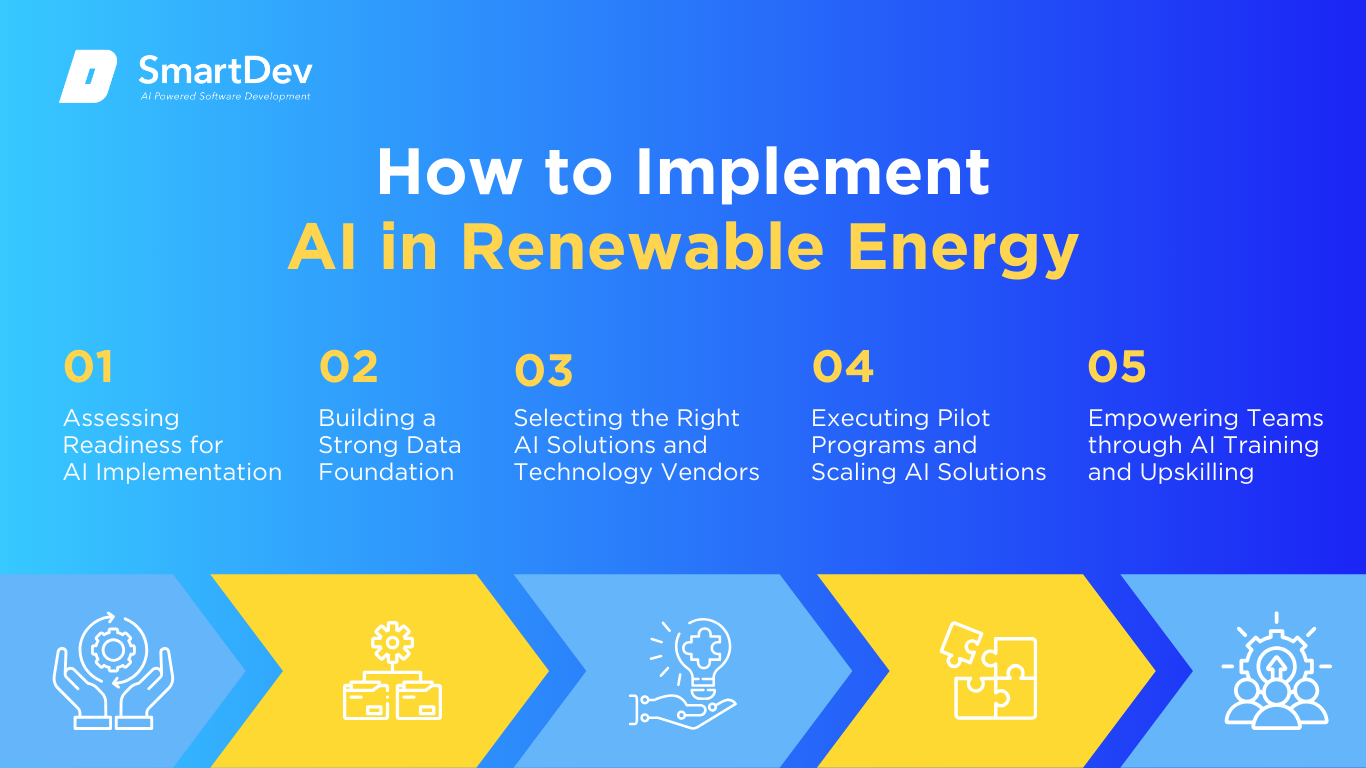
Step 1: Assessing Readiness for AI Adoption
Before integrating AI into renewable energy operations, it’s essential to assess your organization’s digital maturity. Start by identifying areas where manual processes can be optimized, such as energy forecasting, maintenance scheduling, or grid management. These tasks are prime candidates for AI, offering clear benefits and measurable improvements.
You should also evaluate internal readiness for change. AI adoption in energy systems can require a cultural shift, and without strong leadership support, even the most advanced AI solutions may face resistance. Ensuring alignment from key stakeholders is crucial for successful implementation.
Explore our data analytics services to see how we help businesses implement AI solutions that scale.
Step 2: Building a Strong Data Foundation
AI’s effectiveness hinges on clean, organized, and reliable data. Begin by gathering relevant data from energy systems, including historical production data, weather patterns, and grid performance. A well-structured data foundation allows AI models to make accurate predictions and recommendations.
It’s also essential to establish centralized data management systems that all departments can access. Data governance should be a priority, ensuring compliance, security, and quality. A solid data infrastructure makes AI models more reliable and scalable, helping to optimize energy systems over time.
Explore why clean, well-governed data is the foundation of successful AI adoption in our data management guide.
Step 3: Choosing the Right Tools and Vendors
Choosing the right AI tools and vendors is key to successfully implementing AI in renewable energy. Look for solutions tailored to the specific needs of your energy infrastructure, such as predictive maintenance or energy storage optimization. The technology should align with your organization’s goals and seamlessly integrate with existing systems.
Additionally, ensure vendors offer clear terms regarding data usage, privacy, and intellectual property. A trustworthy partner will support your long-term growth and provide consistent updates to keep up with technological advancements in the energy sector.
Step 4: Pilot Testing and Scaling Up
Start by piloting AI solutions in low-risk areas, such as energy demand forecasting or equipment maintenance. Small-scale tests allow you to assess effectiveness, uncover potential issues, and refine your approach. Early successes can build confidence across teams and demonstrate the value of AI.
After conducting pilots, review performance data and feedback to adjust strategies. Once you’ve refined your approach, scaling the solution to other areas will be easier and more effective.
Step 5: Training Teams for Successful Implementation
Prepare your teams to work alongside AI systems by offering targeted training. Help staff understand how AI can complement their roles, whether it’s optimizing energy distribution or improving operational efficiency. Familiarity with AI tools ensures smoother integration and adoption.
Encourage collaboration between technical teams and energy experts. AI is most powerful when it enhances human decision-making, so fostering cooperation ensures better results and more effective workflows. A well-trained workforce ensures sustainable, long-term use of AI in renewable energy systems.
To ensure successful AI integration, institutions should start with a clear roadmap. Our guide for tech leads outlines how to assess readiness and align stakeholders from the start.
Measuring the ROI of AI in Renewable Energy
Key Metrics to Track Success
When measuring the ROI of AI in renewable energy, it’s crucial to focus on key performance indicators (KPIs) that align with your specific goals. Metrics like energy efficiency improvements, reduction in maintenance costs, and system reliability are essential to understanding AI’s impact. Monitoring these KPIs helps assess both operational effectiveness and financial savings.
Additionally, AI’s contribution to grid stability and optimization can be tracked through improvements in energy forecasting and demand response. These metrics highlight how AI can make energy systems more responsive and efficient, directly influencing cost reduction and sustainability outcomes.
Case Studies Demonstrating ROI
AI has demonstrated clear ROI in renewable energy through several notable case studies. AES Corporation has leveraged AI to optimize renewable energy output, predict failures, and enhance load distribution, which has accelerated its transition to renewable sources and improved operational efficiency.
Similarly, Pryon’s AI solution enabled a leading energy company to reduce outage response times and improve issue resolution, resulting in an annual ROI of $6.7 million. These examples illustrate the significant financial and operational benefits of integrating AI into renewable energy operations.
Common Pitfalls and How to Avoid Them
One common pitfall when measuring AI’s ROI is the lack of a solid data baseline before implementation. Without accurate baseline data, it becomes difficult to measure the true impact of AI on energy systems and financial performance. Establishing a clear starting point ensures that any improvements can be effectively tracked.
Another challenge is underestimating the time it takes for AI to deliver optimal results. AI systems often require time to learn and adjust, so it’s important to be patient and realistic about expected outcomes. By setting proper expectations and continuously monitoring progress, organizations can avoid these pitfalls and ensure successful AI adoption.
Learn how to evaluate AI model effectiveness and ROI with our practical guide on AI performance metrics.
Future Trends of AI in Renewable Energy
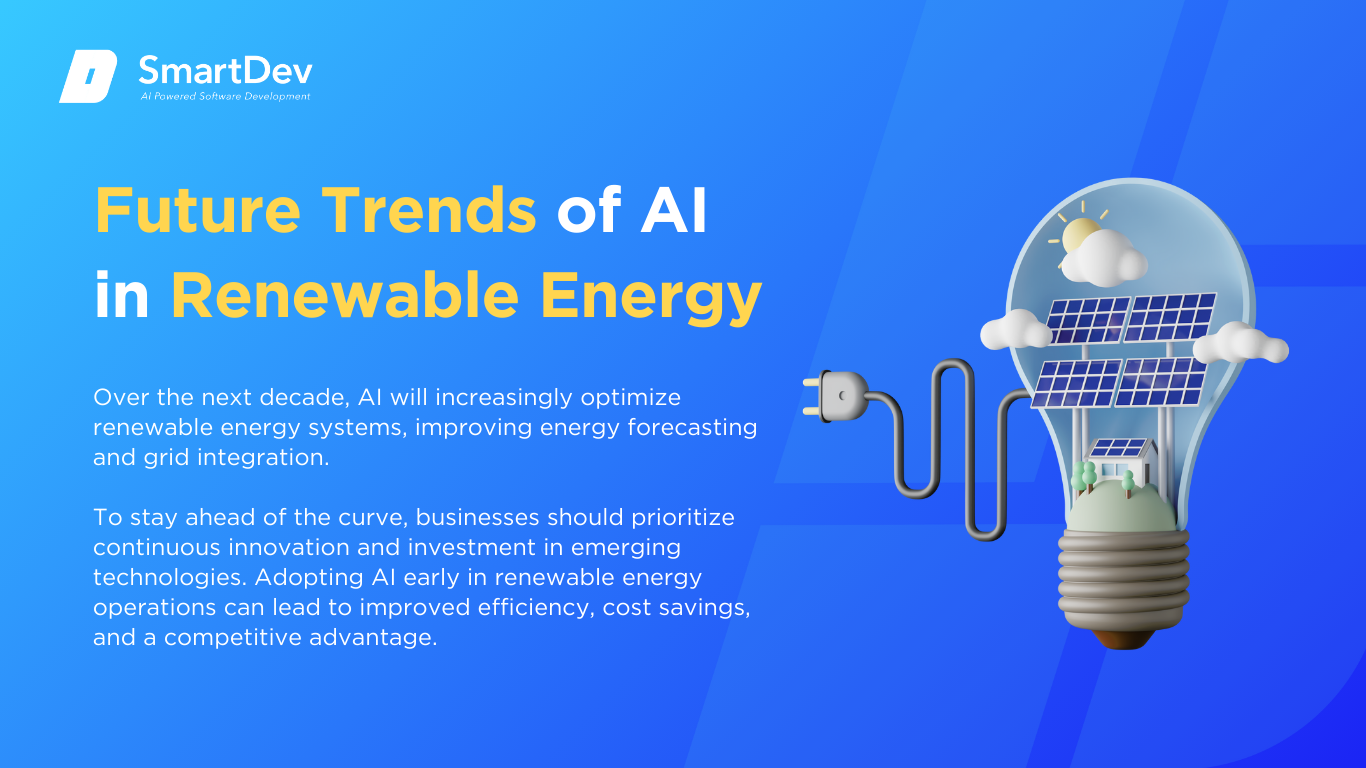
Predictions for the Next Decade
Over the next decade, AI will increasingly optimize renewable energy systems, improving energy forecasting and grid integration. Machine learning and predictive analytics will enhance the efficiency of energy generation and distribution, ensuring more reliable management of renewable sources like wind and solar.
AI will also drive advancements in energy storage and decentralized systems. Smarter energy storage management will optimize battery performance, while AI will enable virtual power plants and peer-to-peer energy trading, fostering a more flexible and sustainable global energy network.
To see which emerging technologies are shaping AI adoption in the next decade, our IT landscape trends recap and guide for business to intergrating AI in 2025 breaks down the must-watch shifts for business leaders.
How Businesses Can Stay Ahead of the Curve
To stay ahead of the curve, businesses should prioritize continuous innovation and investment in emerging technologies like AI. Adopting AI early in renewable energy operations can lead to improved efficiency, cost savings, and a competitive advantage. Staying informed about industry trends and collaborating with technology providers will also help businesses remain adaptable to future advancements.
Focusing on a data-driven culture and building strong data infrastructure is also key. By leveraging reliable data, businesses can optimize energy systems, improve sustainability, and make better decisions, ensuring they lead in the evolving renewable energy sector.
Conclusion
Key Takeaways
AI is revolutionizing the renewable energy sector by improving efficiency, cutting costs, and enhancing sustainability. Key applications like predictive maintenance, energy forecasting, and smart grid optimization boost the reliability of renewable energy systems, while AI-driven energy storage management maximizes the use of intermittent sources like wind and solar.
As AI technology advances, it will further enable smarter, decentralized energy systems. Companies that embrace AI early and invest in robust data infrastructure will remain competitive and drive innovation, positioning themselves to lead in the transition to cleaner, more efficient energy solutions.
Moving Forward: Embracing AI for a Sustainable Energy Future
As AI continues to reshape the renewable energy landscape, now is the time to integrate AI-driven solutions to optimize efficiency, reduce costs, and drive sustainability. From improving energy forecasting to enhancing grid management and predictive maintenance, AI is essential for businesses looking to stay competitive and contribute to a greener future.
At SmartDev, we specialize in AI-powered solutions tailored to the renewable energy sector. Whether you’re enhancing energy storage management, optimizing grid performance, or automating maintenance schedules, our team helps you implement cutting-edge technologies that create long-term value.
Explore our AI-powered software development services to see how we create custom solutions for energy data integration, predictive analytics, and real-time grid management.
Contact us today to discover how AI can transform your energy strategy and support smarter, more efficient decision-making across your organization.
—
References:
- Artificial Intelligence (AI) in Renewable Energy Market Size, Share and Trends 2025 to 2034 | Precedence Research
- A New AI Playbook for Renewable Energy Companies | Boston Consulting GroupGroup
- Great Britain on track for periods of zero carbon electricity in 2025 | National Energy System Operator (NESO)
- Beat the lag: EDF launches weekly price forecasting service for consumers | EDF EnergyEnergy
- NREL’s Artificial Intelligence Work Reveals Benefits to Wind Industry | NREL (.gov)
- The advanced digital platform for solar, wind, and energy storage | Fluence
- From capture to storage: AI transforming the carbon cycle | Energy Tech Summit 2026
- Neoen and Tesla deliver innovative inertia services at Hornsdale Power Reserve big battery in Australia | Neoen
- 92.4% Capture Rate at Petra Nova — that’s a CCS Success | CCS Knowledge Centre
- AES Transforms its Energy Business with AI and H2O.ai | H2O.ai
- Pryon’s AI Data Mastery: The Key to Unlocking Enterprise ROI in the Age of Generative AI | AInvest


